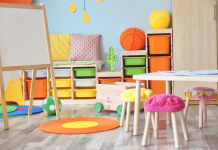
Recent events have many of us suddenly and unexpectedly homeschooling.
You may be asking yourself: What do I do? Where do I start?
Here are some practical tips on how to get started!
- Set the expectations – This is new for you and your child. Talk about it. Let them know that you are learning how to do this together. You both will make mistakes and you both will learn from them. Much grace!
- Set up your school space – You don’t need to knock down or put up walls for this! Find a spot in your house to be home base for home school. Make sure you have a table and chairs that you can either leave set up for each or set up quickly each evening. Gather pens, pencils, scissors, markers, etc. and find a spot for them in your school space.
- Set a schedule – Kids (and moms) need structure, so make a schedule. Be sure to include breaks (5, 10, or 15 minutes) and these should be active or interactive such as stretches, walk around the block, or a quick game of Spot It!. Go Noodle and Fitbit videos are great for these too. Kids need to move, even when they’re inside!
- Get up and get ready – While it is tempting to stay in pajamas and sleep late, get up and get ready. You don’t have to put on a three-piece suit and full makeup, but keep your morning routine. Our minds and bodies react to these signals. Get dressed. Put on mascara. Eat breakfast. Make sure your kid gets ready too.
- Move to “teacher mode” – As a mom, we often remind kids of what they should already know to do; this is “mom mode.” “Teacher mode” guides students through learning new things and asks them questions about things they already know. It also requires much grace because they don’t know how to do things yet.
Mom Mode – Read your book.
Teacher Mode – We are learning about turtles. What do you know about turtles? What does the book tell us about turtles?
See the difference? - Find your friends – Use social networking tools to help each other and stay connected. GroupMe is a great way to connect through group texts with other parents from school. Maybe one of them understands the math question and can explain it! Marco Polo app allows for short videos back & forth, so kids can connect with each other and with teachers.
- Activate art, music, etc. – This can be a fun time to share your favorite 90s album with your kid or learn about chemistry through baking cupcakes. Grab some craft kits online and build in creativity time. Put together a puzzle or build something with Legos.
- Rely on resources – Schools will provide some content for your kids, but that may take a while and may not be enough (they are working as fast as they can and are figuring this out, too). Good news: many online resources have made their content available for you! Below are the ones we know of now, and please comment below with others!
Age of Learning – use code SCHOOL7771 for sites below
- ABCmouse, for ages 2 to 8
- Adventure Academy, for students ages 8 to 13
- ReadingIQ, a digital library and literacy platform is available for children 12 and under
Curriculum Associates – printable at-home activity packs available for students that include self-directed and practice exercises. Reading and math packets are available for each grade from kindergarten through grade 8.
Edsitement – National Endowment for the Humanities curriculum site
Exploratorium – 285 science activities, called “science snacks,” which use “cheap, readily available materials” and can be done at home.
Prodigy.com – math games, many services free
Quizlet – many services available free, including its classroom games and flashcard study guides.
We the Parents – Best Science Kits list















